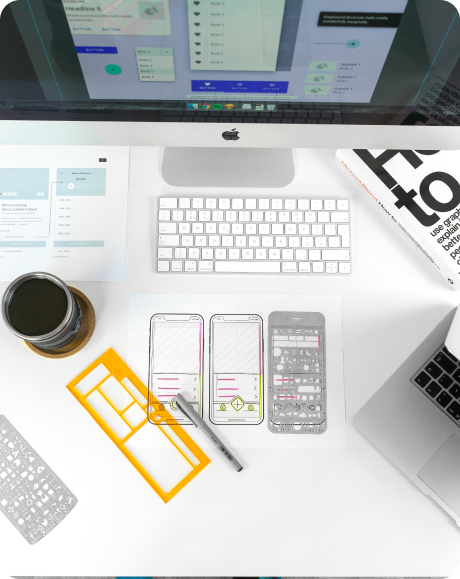
In today’s crowded digital marketplace, standing out from the competition is more challenging than ever. Businesses are not only competing on the quality of their products or services but also on how effectively they can communicate their value to potential customers. This is where Branding & Graphic Design plays a pivotal role. Your brand is more than just a logo or a color scheme; it’s the story you tell, the promise you make, and the experience you deliver to your customers. And graphic design is the visual language that helps convey that story in a compelling, consistent, and recognizable way.
UI/UX Design: The Foundation of Effective Digital Branding
At the heart of successful digital branding lies UI/UX design—the process of designing interfaces that provide an optimal user experience. User interface design (UI) focuses on the aesthetics of your digital platforms, ensuring that every visual element aligns with your brand identity. User experience (UX) design, on the other hand, is about the functionality and ease of use, ensuring that every interaction a user has with your brand is intuitive and enjoyable.
When done right, UI/UX design can significantly impact how users perceive your brand. For example, a well-designed website or app that is easy to navigate and visually appealing will not only attract visitors but also encourage them to engage with your content, explore your products, and eventually convert into loyal customers. Interaction design is a key component here, focusing on creating engaging elements like animations, hover effects, and transitions that make the user experience more dynamic and enjoyable.
One of the most critical aspects of UI/UX design is responsive design—ensuring that your website or application looks and functions perfectly on all devices, from desktops to smartphones. As mobile usage continues to rise, having a responsive design is no longer optional but a necessity. Additionally, accessibility should be a core consideration in your design process, ensuring that your digital platforms are usable by everyone, including those with disabilities.
Web Application Design: A Seamless User Journey
As businesses increasingly move their operations online, web application design has become a crucial aspect of Branding & Graphic Design. A web application is often the primary way customers interact with your brand, making it essential to provide a seamless and intuitive experience. User journey mapping helps in visualizing the paths users take through your application, allowing you to optimize each step for better engagement and conversion.
Effective web application design requires a deep understanding of information architecture—the organization and structuring of content in a way that makes it easily accessible and navigable for users. A well-structured application not only enhances the user experience but also reinforces your brand’s professionalism and attention to detail.
Mobile App Design: Branding on the Go
In today’s mobile-first world, having a strong presence on mobile platforms is crucial. Mobile app design is a specialized area of Branding & Graphic Design that focuses on creating intuitive, engaging, and visually appealing apps that reflect your brand’s identity. A key aspect of this is mobile UI, which involves designing the interface specifically for smaller screens while ensuring a consistent brand experience across all devices.
With the increasing demand for apps that work seamlessly across multiple platforms, cross-platform design has become more important than ever. This approach allows businesses to reach a broader audience by ensuring that their app provides a consistent user experience on both iOS and Android devices. Responsive app design plays a crucial role here, ensuring that your app adapts to different screen sizes and resolutions without compromising on usability or aesthetics.
Another critical component of mobile app design is gesture design—the creation of intuitive touch gestures like swipes, taps, and pinches that make the app more interactive and user-friendly. Combined with well-thought-out mobile interactions and user flow, this ensures that users can navigate your app with ease and enjoy a seamless experience that reinforces your brand’s image.
Logo Design: The Face of Your Brand
A logo is often the first thing people associate with a brand. It is the symbol that represents your business in the minds of consumers. Logo design is, therefore, a fundamental part of Branding & Graphic Design. Whether you’re launching a new brand or looking to refresh an existing one, your logo must be distinctive, memorable, and reflective of your brand’s values and personality.
The process typically begins with concept development, where designers explore different ideas and visual styles that could represent your brand. This phase is crucial as it lays the foundation for the custom logo design that will be developed. A well-designed logo should be versatile, meaning it can be easily adapted for various applications, such as social media, websites, packaging, and print materials.
For businesses looking to modernize their image, logo redesign offers an opportunity to update and refine their brand symbol while maintaining a connection to their existing identity. Additionally, creating logo variations (e.g., vertical, horizontal, monochrome) ensures that your logo remains effective across different mediums and contexts.
Brand & Visual Design: Crafting a Cohesive Identity
Beyond the logo, Brand & Visual Design encompasses all the visual elements that make up your brand’s identity. This includes everything from color schemes and typography to imagery and layout. A cohesive visual identity is essential for creating a consistent brand experience across all touchpoints, whether it’s a website, mobile app, social media, or print materials.
Brand identity goes beyond aesthetics—it’s about conveying your brand’s values, mission, and personality through design. Developing a strong visual identity requires careful consideration of how each design element works together to create a unified brand image. For example, the choice of colors and fonts should not only be visually appealing but also align with the brand’s messaging and target audience.
To ensure consistency, it’s essential to develop comprehensive brand guidelines that outline how your brand’s visual elements should be used across different platforms and media. These guidelines serve as a reference for designers, marketers, and anyone else involved in creating brand materials, ensuring that your brand’s identity remains consistent and recognizable.
Marketing Collateral: Extending Your Brand’s Reach
Finally, Marketing Collateral plays a vital role in extending your brand’s reach and communicating your message to a broader audience. This includes a wide range of materials, such as brochures, flyers, business cards, posters, banners, and more. Each piece of collateral should be designed with your brand’s visual identity in mind, ensuring a consistent and professional appearance across all platforms.
In today’s digital age, email templates and social media branding have also become essential components of Marketing Collateral. Well-designed email templates not only look professional but also reinforce your brand’s identity with every communication. Similarly, visually cohesive social media assets help create a consistent brand presence across platforms, increasing recognition and engagement.
Packaging design is another critical aspect of Marketing Collateral, especially for product-based businesses. Effective packaging design not only protects the product but also serves as a powerful marketing tool that can attract customers and influence their purchasing decisions.
Conclusion
In conclusion, Branding & Graphic Design is more than just creating pretty visuals—it’s about crafting a cohesive and memorable brand identity that resonates with your audience. From UI/UX design and mobile app design to logo design and marketing collateral, each element plays a crucial role in shaping how your brand is perceived. By investing in professional Branding & Graphic Design, you can create a strong, recognizable brand that stands out in the crowded marketplace and leaves a lasting impression on your customers.
